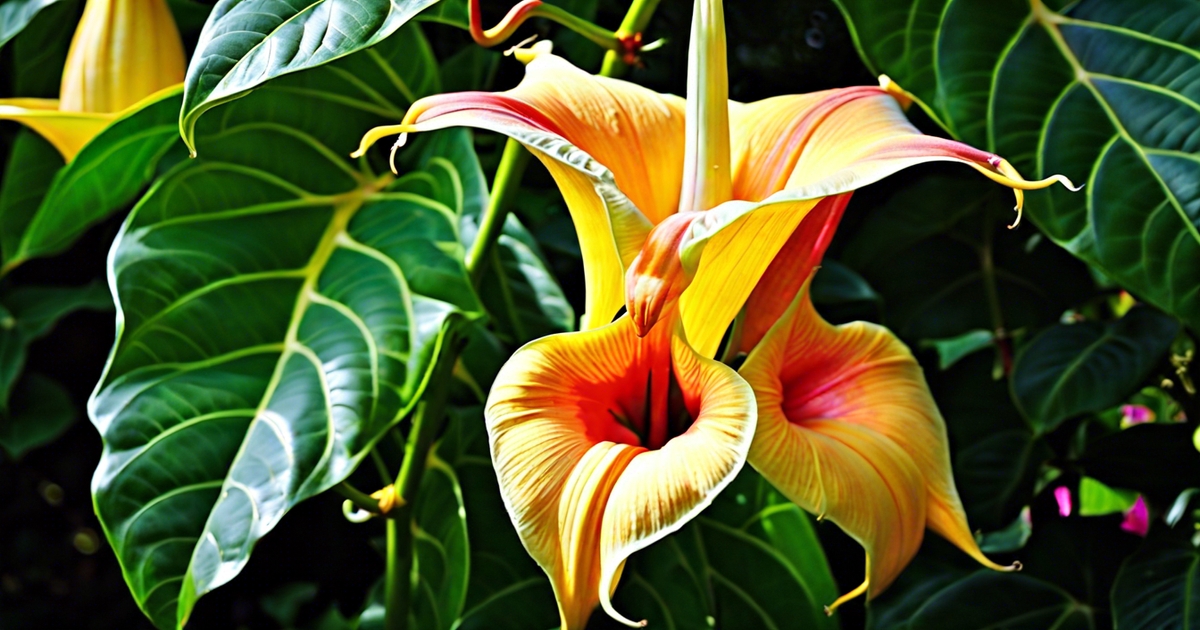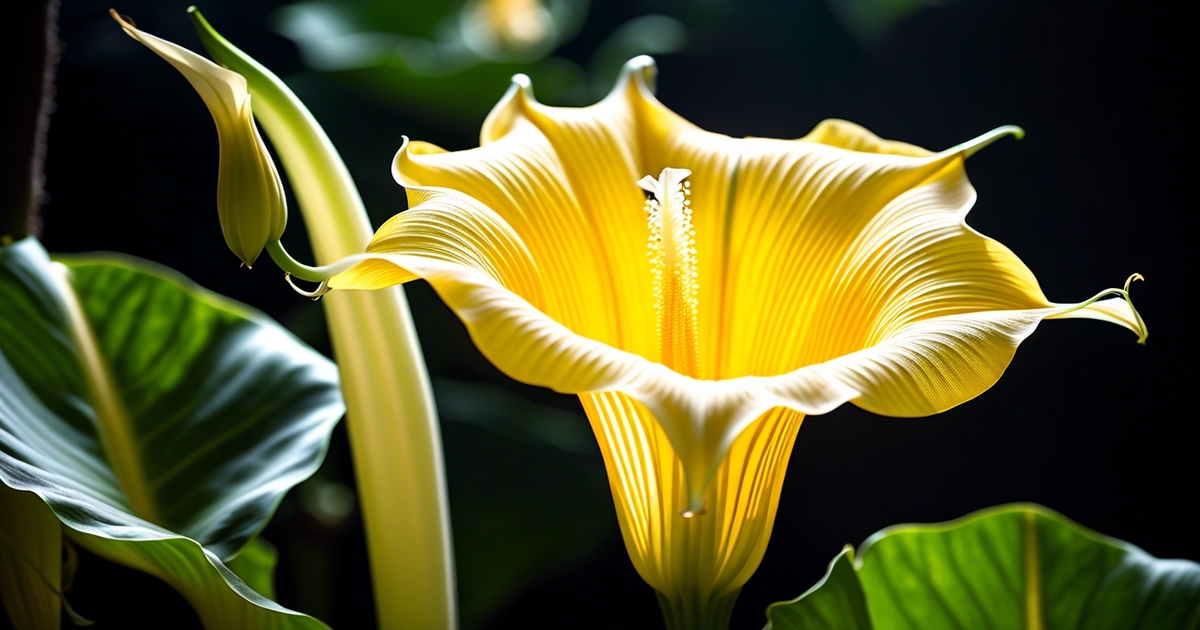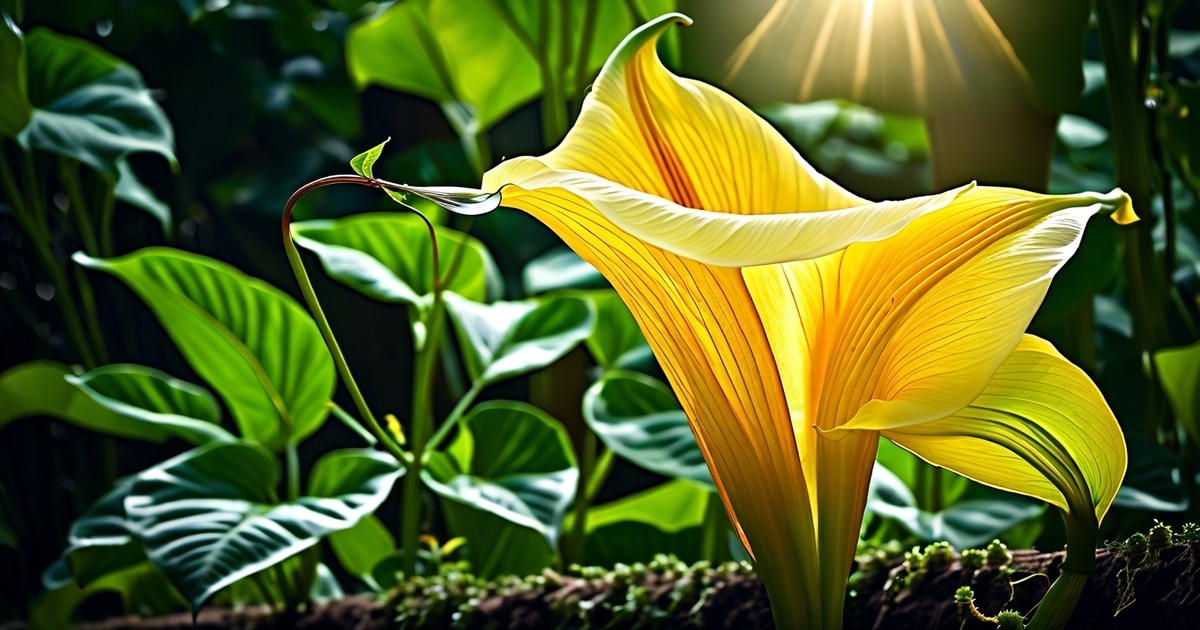Key Takeaways
- Properly understanding the description and taxonomy of Angel’s Trumpet is crucial for its care and maintenance.
- Consider Angel’s Trumpet’s distribution, habitat, and ecology when deciding on the ideal growing conditions.
- Different species of Brugmansia may have varying characteristics and requirements, so research specific species for tailored care.
- Adapting light and temperature conditions according to the growth needs of Angel’s Trumpet is essential for its health.
- Maintaining the right soil composition, watering schedule, and fertilization routine is key to promoting proper care and long root growth in Brugmansia plants.
- To propagate and encourage blooms in Brugmansia, follow proper techniques such as stem cuttings and water and provide adequate nutrients and care.
Step into the intriguing world of Angel’s Trumpet, a plant with a captivating history deeply rooted in folklore and medicinal uses. This enchanting flower, known for its trumpet-shaped blooms and sweet fragrance, holds a dark secret within its beauty – potent hallucinogenic properties that have fascinated and alarmed throughout history. From ancient civilizations to modern-day botanical enthusiasts, the Angel’s Trumpet continues to mesmerize with its allure and danger, making it a subject of curiosity and caution.
Description and Taxonomy of Angel’s Trumpet
Trumpet-shaped Flowers
Angel’s trumpet is recognized for its striking trumpet-shaped flowers that can grow up to 20 inches long. The flowers dangle elegantly from the plant, creating a mesmerizing display. These large blooms give the plant a unique and enchanting appearance.
The colors of angel’s trumpet flowers vary widely, including shades of white, yellow, pink, and even orange. This diversity in color adds to the plant’s allure, making it a popular choice for gardens seeking vibrant and eye-catching blooms.
Brugmansia in Solanaceae Family
Scientifically known as Brugmansia, Angel’s trumpet belongs to the Solanaceae family, which includes other well-known plants like tomatoes and potatoes. This classification places angel’s trumpet among a diverse group of flowering plants with distinct characteristics.
- Large, trumpet-shaped flowers
- Wide range of colors (white, yellow, pink, orange)
- Belongs to the Solanaceae family
Distribution, Habitat, and Ecology of Angel’s Trumpet
Native Regions
Angel’s trumpet originates from South America, particularly the Andes region. It is commonly seen in tropical and subtropical areas worldwide.
Angel’s trumpet thrives in regions with high humidity. It prefers moist, well-drained soil for optimal growth.
Global Presence
This plant can be found across various countries due to its adaptability to different climates. Its striking appearance makes it a popular choice for gardens and landscapes.
In regions like Florida and California in the United States, Angel’s trumpet is cultivated as an ornamental plant due to its large, fragrant flowers.
Different Species of Brugmansia

Unique Characteristics
Brugmansia comprises species like B. suaveolens, B. arborea, and B. sanguinea, each with distinct traits. These characteristics encompass differences in flower color, size, and fragrance.
Some Brugmansia species are more resilient to colder temperatures than others. This trait is crucial for their survival in regions where temperatures can drop significantly during certain seasons.
Cold Tolerance
The ability of some Brugmansia species to withstand cold climates sets them apart from those that are more sensitive to low temperatures. For example, B. suaveolens might be better suited for cooler areas than other species like B. arborea or B. sanguinea.
- Some Brugmansia species have higher cold tolerance levels.
- Different flower colors, sizes, and fragrances exist among various Brugmansia types.
- Cold-tolerant species like B. suaveolens can thrive in regions with lower temperatures.
Light and Temperature Requirements for Growth
Sunlight Needs
Angel’s trumpet thrives in full sun to partial shade, needing sunlight for optimal growth. It can adapt to different light conditions but flourishes best with ample sunshine.
Angel’s trumpet is a versatile plant that can withstand various temperatures. However, it prefers temperatures between 65-80°F (18-27°C) for ideal growth.
Protection from Extreme Conditions
Extreme heat or frost can harm angel’s trumpet plants, so shielding them from severe weather conditions is crucial. Protecting shade cloth or mulch can help safeguard the plant in regions with scorching summers or frosty winters.
- Angel’s trumpet needs full sun to partial shade.
- The plant prefers temperatures between 65-80°F (18-27°C).
- Protection from extreme heat or frost is essential for the plant’s well-being.
Soil, Watering, and Fertilizing Needs
Proper Soil Composition
Angel’s trumpet thrives in well-draining soil with a high content of organic matter. This type of soil allows the plant’s roots to easily access essential nutrients.
To ensure optimal growth, consider a mix of garden soil with compost or peat moss to create the perfect environment for your angel’s trumpet.
Watering and Fertilizing Tips
Maintaining proper watering is crucial for Angel’s trumpet; it requires consistent moisture without becoming waterlogged. A good rule of thumb is to keep the soil moist but not soggy.
Using a balanced fertilizer every two weeks during the growing season will give your plant the necessary nutrients for healthy development. Remember that angel’s trumpet is considered a heavy feeder and benefits greatly from regular fertilization.
- Pros: Promotes healthy growth and enhances blooming.
- Cons: Overwatering can lead to root rot.
- Key information: Well-draining soil rich in organic matter is essential.
- Examples: Mixing garden soil with compost or peat moss.
Propagating and Encouraging Blooms in Brugmansia
Propagation Methods
Angel’s trumpet can be easily propagated from cuttings or seeds. Taking cuttings from a healthy plant and rooting them in water or soil is a common way to propagate Angel’s trumpet. Seeds, on the other hand, can be collected from the plant’s pods after they have dried out.
Cuttings:
- Easily done from healthy plants
- Rooting in water or soil
Seeds:
- Collected from dried-out pods
- Requires patience for germination
Encouraging Abundant Blooms
Pruning and shaping your angel’s trumpet plant are crucial steps to encourage branching and more abundant blooms. By selectively trimming branches, you promote new growth points that lead to a bushier plant with more flowers.
Balanced Fertilization:
- Higher phosphorus content needed
- Promotes blooming
Fertilizing for Blooms
A balanced fertilizer with higher phosphorus content is essential for promoting blooming in angel’s trumpet plants. A fertilizer specifically formulated for flowering plants can help ensure your Brugmansia produces an abundance of its signature pendulous pink flowers.
Common Pests, Problems, and Toxicity Awareness
Common Pests
Aphids, whiteflies, and spider mites are common pests that can harm angel’s trumpet plants. These tiny insects feed on the plant’s sap, causing damage to its leaves and flowers. To combat these pests, using insecticidal soap can effectively control their population.
Angel’s trumpet plants are susceptible to infestations by spider mites, known for spinning webs on the leaves. Regularly inspecting the plant for any signs of these pests is crucial in maintaining its health.
- Aphids
- Whiteflies
- Spider mites
Problems and Toxicity Awareness
Overwatering or poorly draining soil can result in root rot in angel’s trumpet plants. This condition causes the roots to decay due to excessive moisture, leading to wilting leaves and stunted growth. Ensuring proper drainage is essential for preventing this issue.
Handling angel’s trumpet with caution is vital as all parts of the plant contain toxic alkaloids such as scopolamine, hyoscyamine, and atropine. Ingestion of any part of the plant can cause symptoms like hallucinations, blurred vision, rapid heartbeat, and even death if consumed in large quantities.
- Root rot due to overwatering
- Toxic alkaloids present in all parts of the plant
Historical Uses and Cultivation Insights

Traditional Medicinal Uses
Angel’s trumpet has a long history of traditional medicinal use in South America. Indigenous tribes used it for various ailments and spiritual ceremonies. The plant’s extracts were believed to have healing properties.
In some cultures, the flowers of Angel’s trumpet were utilized in religious ceremonies due to their hallucinogenic effects. Despite its toxicity, certain communities revered the plant for its psychoactive qualities.
Global Cultivation
The cultivation of angel’s trumpet has spread worldwide due to its ornamental value in gardens and landscapes. Its large, fragrant flowers make it a popular choice for decorative purposes.
- Pros:
- Ornamental beauty in gardens.
- Fragrant blooms add aesthetic appeal.
- Cons:
- Toxicity poses risks if ingested.
- Requires caution around children and pets.
With its rich history of traditional uses and global cultivation for ornamental purposes, Angel’s trumpet continues to captivate individuals with its beauty while warranting awareness of its toxic nature.
Final Remarks
You’ve journeyed through the vibrant world of Angel’s Trumpet, uncovering its beauty, care needs, and historical significance. Now equipped with knowledge of its taxonomy, habitat, growth requirements, and propagation techniques, you’re ready to nurture your own Brugmansia plant. Watch out for pests, provide ample sunlight, and maintain well-draining soil for optimal growth.
As you embark on your gardening adventure with Angel’s Trumpet, embrace the process with patience and dedication. Experiment with different fertilizers, watering schedules, and pruning techniques to witness this plant’s spectacular blooms. Share your experiences with fellow gardeners, seek advice when needed, and most importantly, enjoy the rewarding journey of cultivating these enchanting plants.
Frequently Asked Questions
How can I identify different species of Brugmansia?
Brugmansia species can be distinguished by flower color, size, shape, and leaf characteristics. Consulting botanical guides or experts can help in accurate identification due to variations within the genus.
What are the light and temperature requirements for Angel’s Trumpet growth?
Angel’s Trumpet thrives in full sun to partial shade conditions with temperatures above 50°F (10°C). Protecting the plant from frost is crucial as it prefers warmer climates for optimal growth.
How should I propagate Brugmansia plants successfully?
Propagate Brugmansia through stem cuttings taken during the active growing season. Ensure the cutting has at least two nodes and remove lower leaves before planting in a well-draining medium. Maintain consistent moisture levels for successful propagation.
Are there any common pests that affect Angel’s Trumpet plants?
Common pests that infest Angel’s Trumpet include aphids, spider mites, and whiteflies. Regularly inspecting the plant for signs of infestation, like yellowing leaves or webbing, can help in early detection and appropriate pest control measures.
What historical uses are associated with Angel’s Trumpet cultivation?
Historically, various cultures have used Angel’s Trumpet ceremonially or medicinally due to its psychoactive properties. However, caution is advised as all parts of the plant contain toxic compounds that can be harmful if ingested.

